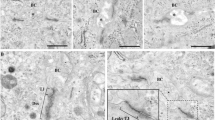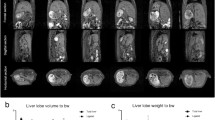Abstract
Background and aims
No studies have investigated histologic changes caused by simultaneous segmental obstruction of the bile duct and portal vein in human liver.
Patients/Methods
Liver tissues with simultaneous obstruction of the segmental bile duct and portal vein (O+/+ liver), with segmental bile duct obstruction alone (O+/− liver), and without obstruction (O−/− liver) were obtained from patients who underwent hepatectomy, and studied morphologically and immunohistochemically.
Results
In O+/+ liver, the proportional area consisting of hepatocytes was significantly less (31.0±25.8%) than in O+/− liver (78.4±18.9%) or O−/− liver (86.5±9.2%). In contrast, the proportional area consisting of biliary epithelial cells was significantly higher in O+/+ liver (9.1±6.1%) than in O+/− liver (1.6±1.5%) or O−/− liver (0.7±0.6%). The proportional area consisting of fibrous tissue also was significantly higher in O+/+ liver than in the other two groups. In O+/+ liver, some cells located at the periphery of hepatocyte areas were immunoreactive for both hepatocyte and biliary epithelial cell markers.
Conclusion
Simultaneous segmental obstruction of the bile duct and portal vein induces a marked ductular increase, periportal fibrosis, and a reduction in the number of hepatocytes in human liver tissue.





Similar content being viewed by others
References
Desmet V, Roskams T, Van Eyken P (1995) Ductular reaction in the liver. Pathol Res Pract 191:513–524
Nakamura Y, Ohta G (1986) Immunohistochemical study on bile ductular proliferation in various hepatobiliary diseases. Liver 6:205–211
Masuko K, Rubin E, Popper H (1964) Proliferation of bile ducts in cirrhosis. Arch Pathol 78:421–431
Slott PA, Liu MH, Tavoloni N (1990) Origin, pattern, and mechanism of bile duct proliferation following biliary obstruction in the rat. Gastroenterology 99:466–477
Gall JA, Bhathal PS (1990) Origin and involution of hyperplastic bile ductules following total biliary obstruction. Liver 10:106–115
Sirica AE, Gainey TW, Mumaw VR (1994) Ductular hepatocytes: evidence for a bile ductular cell origin in furan-treated rats. Am J Pathol 145:375–383
Crosby HA, Hubscher S, Fabris L, Joplin R, Sell S, Kelly D, Strain AJ (1998) Immunolocalization of putative human liver progenitor cells in livers from patients with end-stage primary biliary cirrhosis and sclerosing cholangitis using the monoclonal antibody OV-6. Am J Pathol 152:771–779
Van Eyken P, Sciot R, Desmet VJ (1989) A cytokeratin immunohistochemical study of cholestatic liver disease: evidence that hepatocytes can express "bile duct-type" cytokeratins. Histopathology 15:125–135
Bartek J, Bartkova J, Taylor-Papadimitriou J, Rejthar A, Kovarik J, Lukas Z, Vojtesek B (1986) Differential expression of keratin 19 in normal human epithelial tissues revealed by monospecific monoclonal antibodies. Histochem J 18:565–575
Osborn M, Van Lessen G, Weber K, Kloppel G, Altmannsberger M (1986) Methods in laboratory investigation. Differential diagnosis of gastrointestinal carcinomas by using monoclonal antibodies specific for individual keratin polypeptides. Lab Invest 55:497–504
Yabushita K, Yamamoto K, Ibuki N, Okano N, Matsumura S, Okamoto R, Shimada N, Tsuji T (2001) Aberrant expression of cytokeratin 7 as a histological marker of progression in primary biliary cirrhosis. Liver 21:50–55
James J, Lygidakis NJ, Van Eyken P, Tanka AKF, Bosh KS, Ramaekers FCS, Desmer V (1989) Application of keratin immunocytochemistry and Sirius red staining in evaluating intrahepatic changes with acute extrahepatic cholestasis due to hepatic duct carcinoma. Hepatogastroenterology 36:151–155
Shiomi M, Kamiya J, Nagino M, Uesaka K, Sano T, Hayakawa N, Kanai M, Yamamoto H, Nimura Y (2001) Hepatocellular carcinoma with biliary tumor thrombi: aggressive operative approach after appropriate preoperative management. Surgery 129:692–698
Nimura Y, Hayakawa N, Kamiya J, Maeda S, Kondo S, Yasui A, Shionoya S (1991) Combined portal vein and liver resection for carcinoma of the biliary tract. Br J Surg 78:727–731
Wennerberg AE, Nalesnik MA, Coleman WB (1993) Hepatocyte paraffin 1: a monoclonal antibody that reacts with hepatocytes and can be used for differential diagnosis of hepatic tumors. Am J Pathol 143:1050–1054
Sasaki K, Murakami T, Kawasaki M, Takahashi M (1987) The cell cycle associated change of the Ki-67 reactive nuclear antigen expression. J Cell Physiol 133:579–584
Shi SR, Key ME, Kalra KL (1991) Antigen retrieval in formalin-fixed, paraffin-embedded tissues: an enhancement method for immunohistochemical staining based on microwave oven heating of tissue sections. J Histochem Cytochem 39:741–748
Takiya S, Tagaya T, Takahashi K, Kawashima H, Kamiya M, Fukuzawa Y, Kobayashi S, Fukatsu A, Katoh K, Kakumu S (1995) Role of transforming growth factor beta 1 on hepatic regeneration and apoptosis in liver diseases. J Clin Pathol 48:1093–1097
Rous P, Larimore LD (1920) Relation of the portal blood to liver maintenance: a demonstration of liver atrophy conditional on compensation. J Exp Med 31:609–632
Takeuchi E, Nimura Y, Mizuno S, Nagino M, Kawaguchi MS, Izuta S, Yoshida S (1996) Ligation of portal vein branch induces DNA polymerases α, δ, and ε in nonligated lobes. J Surg Res 65:15–24
Nagino M, Nimura Y, Kamiya J, Kondo S, Uesaka K, Kin Y, Hayakawa N, Yamamoto H (1995) Changes in hepatic lobe volume in biliary tract cancer patients after right portal vein embolization. Hepatology 21:434–439
Imamura H, Shimada R, Kubota M, Matsuyama Y, Nakayama A, Miyagawa S, Makuuchi M, Kawasaki S (1999) Preoperative portal vein embolization: an audit of 84 patients. Hepatology 29:1099–1105
Harada H, Imamura H, Miyagawa S, Kawasaki S (1997) Fate of the human liver after hemihepatic portal vein embolization: cell kinetic and morphometric study. Hepatology 26:1162–1170
Hillan KJ, Burt AD, George WD, MacSween RN, Griffiths MR, Bradley JA (1989) Intrasplenic hepatocytes transplantation in rats with experimental liver injury: morphological and morphometric studies. J Pathol 159:67–73
Kubota K, Makuuchi M, Kusaka K, Kobayashi T, Miki K, Hasegawa K, Harihara Y, Takayama T (1997) Measurement of liver volume and hepatic functional reserve as a guide to decision-making in resectional surgery for hepatic tumors. Hepatology 26:1176–1181
Author information
Authors and Affiliations
Corresponding author
Rights and permissions
About this article
Cite this article
Kyokane, T., Nagino, M., Kamiya, J. et al. Simultaneous segmental obstruction of bile duct and portal vein markedly changes a population of biliary and hepatic cells in human liver. Langenbecks Arch Surg 388, 270–275 (2003). https://doi.org/10.1007/s00423-003-0380-8
Received:
Accepted:
Published:
Issue Date:
DOI: https://doi.org/10.1007/s00423-003-0380-8




